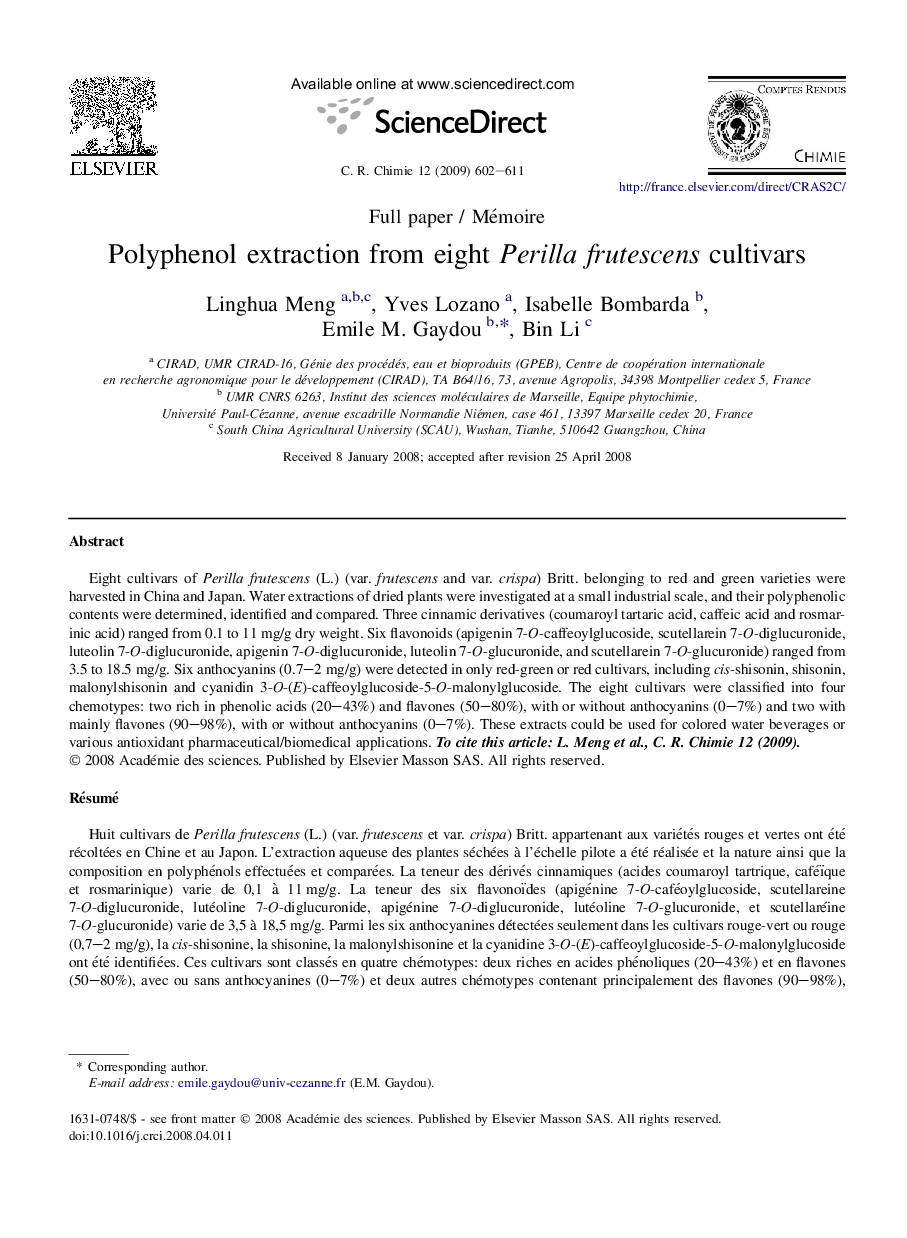| Article ID | Journal | Published Year | Pages | File Type |
|---|---|---|---|---|
| 171358 | Comptes Rendus Chimie | 2009 | 10 Pages |
Eight cultivars of Perilla frutescens (L.) (var. frutescens and var. crispa) Britt. belonging to red and green varieties were harvested in China and Japan. Water extractions of dried plants were investigated at a small industrial scale, and their polyphenolic contents were determined, identified and compared. Three cinnamic derivatives (coumaroyl tartaric acid, caffeic acid and rosmarinic acid) ranged from 0.1 to 11 mg/g dry weight. Six flavonoids (apigenin 7-O-caffeoylglucoside, scutellarein 7-O-diglucuronide, luteolin 7-O-diglucuronide, apigenin 7-O-diglucuronide, luteolin 7-O-glucuronide, and scutellarein 7-O-glucuronide) ranged from 3.5 to 18.5 mg/g. Six anthocyanins (0.7–2 mg/g) were detected in only red-green or red cultivars, including cis-shisonin, shisonin, malonylshisonin and cyanidin 3-O-(E)-caffeoylglucoside-5-O-malonylglucoside. The eight cultivars were classified into four chemotypes: two rich in phenolic acids (20–43%) and flavones (50–80%), with or without anthocyanins (0–7%) and two with mainly flavones (90–98%), with or without anthocyanins (0–7%). These extracts could be used for colored water beverages or various antioxidant pharmaceutical/biomedical applications.
RésuméHuit cultivars de Perilla frutescens (L.) (var. frutescens et var. crispa) Britt. appartenant aux variétés rouges et vertes ont été récoltées en Chine et au Japon. L'extraction aqueuse des plantes séchées à l'échelle pilote a été réalisée et la nature ainsi que la composition en polyphénols effectuées et comparées. La teneur des dérivés cinnamiques (acides coumaroyl tartrique, caféïque et rosmarinique) varie de 0,1 à 11 mg/g. La teneur des six flavonoïdes (apigénine 7-O-caféoylglucoside, scutellareine 7-O-diglucuronide, lutéoline 7-O-diglucuronide, apigénine 7-O-diglucuronide, lutéoline 7-O-glucuronide, et scutellaréine 7-O-glucuronide) varie de 3,5 à 18,5 mg/g. Parmi les six anthocyanines détectées seulement dans les cultivars rouge-vert ou rouge (0,7–2 mg/g), la cis-shisonine, la shisonine, la malonylshisonine et la cyanidine 3-O-(E)-caffeoylglucoside-5-O-malonylglucoside ont été identifiées. Ces cultivars sont classés en quatre chémotypes: deux riches en acides phénoliques (20–43%) et en flavones (50–80%), avec ou sans anthocyanines (0–7%) et deux autres chémotypes contenant principalement des flavones (90–98%), avec ou sans anthocyanines (0–7%). Ces extraits aqueux pourraient être utilisés pour la coloration de boissons aqueuses ou bien comme antioxydants naturels dans des applications pharmaceutiques/biomédicales.
